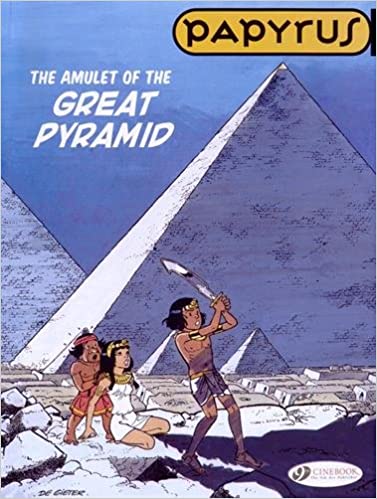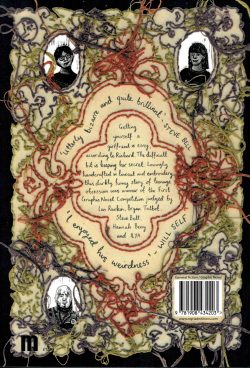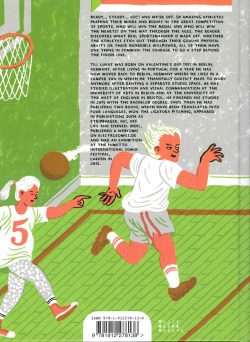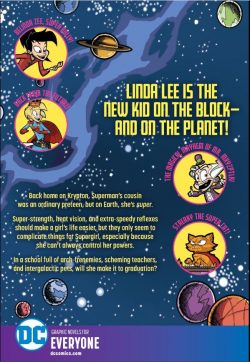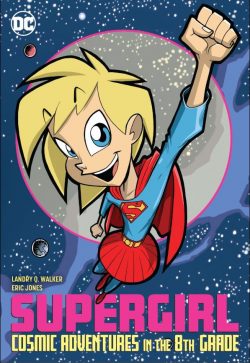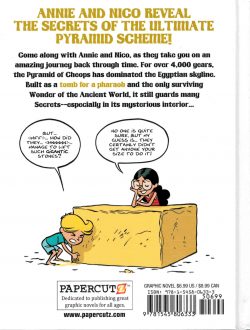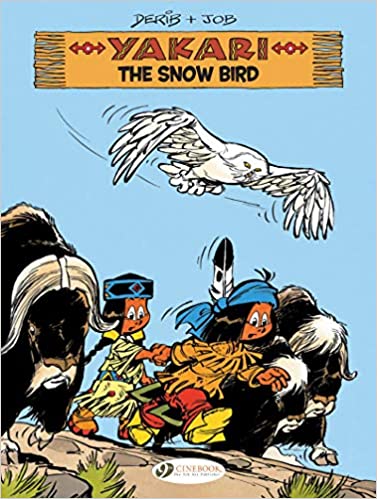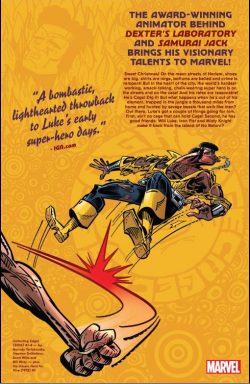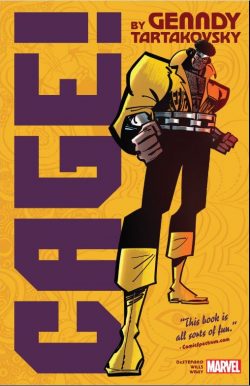

By Derib & Job, translated by Erica Jeffrey (Cinebook)
ISBN: 978-1-90546-004-5 (Album PB)
Children’s magazine Le Crapaud à lunettes was founded in 1964 by Swiss journalist André Jobin who then wrote for it under the pseudonym Job. Three years later he hired fellow French-Swiss artist Claude de Ribaupierre AKA “Deribâ€. The illustrator had launched his own career as an assistant at Studio Peyo (home of Les Schtroumpfs), working on The Smurfs strips for venerable weekly Le Journal de Spirou. Together they created the splendid Adventures of the Owl Pythagore before striking pure comics gold a few years later with their next collaboration.
Derib – equally au fait with enticing, comically dynamic “Marcinelle†cartoon style yarns and devastatingly compelling meta-realistic action illustrated action epics – went on to become one of the Continent’s most prolific and revered creators. It’s a crime that groundbreaking strips such as Celui-qui-est-né-deux-fois, Jo (the first comic ever published dealing with AIDS), Pour toi, Sandra and La Grande Saga Indienne) haven’t been translated into English yet, but we still patiently wait in hope and anticipation…
Many of Derib’s stunning works over the decades feature his cherished Western themes; magnificent geographical backdrops and epic landscapes. Yakari is considered by fans and critics to be the strip which first led him to deserved mega-stardom.
Debuting in 1969, Yakari follows the life of a young Oglala Lakota boy on the Great Plains; set sometime after the introduction of horses by the Conquistadores but before the coming of modern Europeans.
The series – which has generated two separate TV cartoon series and a movie release – has achieved 40 albums: a testament to the strip’s evergreen vitality and brilliance of its creators, even though originator Job has moved on and Frenchman Joris Chamblain assumed the writer’s role in 2016.
Overflowing with gentle whimsy and heady compassion, young Yakari enjoys a largely bucolic existence: at one with nature and generally free from privation or strife. For the sake of our delectation, however, the ever-changing seasons are punctuated with the odd crisis, generally resolved without fuss, fame or fanfare by a little lad who is smart, brave… and can – thanks to the boon of his totem guide the Great Eagle – converse with all animals …
Yakari et le bison blanc was the second collected European album, published in 1976 as the strip continued rapidly rising to huge prominence and critical acclaim.
Transformed to English, Yakari and the White Buffalo begins one cold day on the plains with winter snows still heavy on the ground. With spring delayed, animals and humans are going hungry and when the boy and his pinto mount Little Thunder return to camp, they find his father Bold Gaze has decreed they will move south in search of better prospects.
As they progress across the prairie the buffalo that should form the major part of their diet are nowhere to be found…
Then one day scout Grey Wolf furiously rides in. He has seen the herd. Soon they will all be enjoying the nourishment of Great Spirit Wakonda‘s gift. That night the braves dance in honour of the moving mountains they will soon hunt. Not permitted to join the men, Yakari wanders off with his pony and meets totem spirit Great Eagle in a lush clearing. The noble bird warns him the hunt will not go the way it should and the glum boy heads home with Little Thunder buckling under the weight of firewood the worried yet diligent lad has gathered…
Far away, the braves are baffled and still without meat. The night sky is riven with terrifying lightning and a furious storm. Back at camp, Yakari is scared and worried but soon soothed by elderly Quiet Rock. Eventually, the boy sleeps and is again visited by prophetic dreams. After tracking the buffalo over boiling sandy wastes and through a strange horn-like rock formation, the vision ends with him leading the herd and a great white bull back to the people…
As his mother wakes him in the morning, elsewhere the braves have reached a great desert and, with no sign of the great herd, are forced to split into small scouting parties. With little to do, Yakari and Little Thunder race with boisterous older boy Buffalo Seed and gentle Rainbow. The chase takes them to the top of a hill where he sees the rocky prominence of his dream…
His friends cannot deter Yakari from riding right out into the vast, empty plain and before long both boy and pony suffer the harsh trials of scorching heat and burning thirst. Determined to go on, both are near death when Great Eagle arrives and teaches them the secret of getting water out of the tall cacti around them.
Fortified and reinvigorated, they push on into sandy wastes and the next day are confronted by a towering wall of rock. Unable to climb the forbidding massif, Yakari discusses the problem with his pony and the wise steed suggests that every fence has an opening somewhere…
At last, their patient search reveals a deliciously refreshing waterfall and a tunnel into a lush hidden oasis where the missing buffalo herd is grazing in total secrecy…
As they innocently approach the massive ruminants a young bull furiously attacks, but his charge is intercepted by an immense white buffalo who takes the intruders aside for a quiet chat.
The wise beast explains the nature of the hidden pasture and listens with great care to the tale of woe that has left the Sioux starving. The beast understands the role of all creatures in the grand scheme of life and was already preparing to lead the migration back to the plains when Yakari arrived…
By the time horse and rider have led the herd to the spring plains, the hunters have returned home, but the snowy bovine mountain sagely advises Yakari and Little Thunder to ride away before the braves can arrive to fulfil their role in the eternal cycle of life and death of the plains…
The saga of the valiant little brave who can speak with animals and enjoys a unique place in an exotic world is a decades-long celebration of joyously gentle, moving and inexpressibly entertaining adventures honouring and eulogising an iconic culture with grace, wit, wonder and especially humour. These tales are a masterpiece of kids’ comics literature and Yakari is a series no fan of graphic literature should be without.
Original edition © 1977 Le Lombard/Dargaud by Derib + Job. English translation 2005 © Cinebook Ltd.



